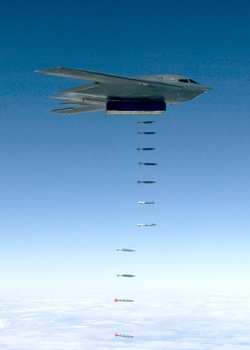Thu, Oct 02, 2003
Five Times the "Impact"
 Northrop Grumman Corporation's
Integrated Systems sector and the US Air Force have successfully
demonstrated the operation of a new smart bomb rack assembly (SBRA)
that increases the B-2 stealth bomber's capacity to deliver smart
(GPS-guided) weapons by a factor of five.
Northrop Grumman Corporation's
Integrated Systems sector and the US Air Force have successfully
demonstrated the operation of a new smart bomb rack assembly (SBRA)
that increases the B-2 stealth bomber's capacity to deliver smart
(GPS-guided) weapons by a factor of five.
In a test conducted Sept. 10 at the Utah Test and Training Range
at Hill Air Force Base, Utah, a B-2 stealth bomber successfully
released 80 independently targeted guided weapons against 80
separate targets. The B-2 released the weapons in a single pass.
The test marks the first time an aircraft has delivered this many
guided independently targeted weapons at one time.
Northrop Grumman, the Air Force's B-2 prime contractor, managed
the development of the SBRA system. It allows the B-2 to carry,
power, control, target and release as many as 80 MIL-STD-1760 smart
weapons, five times its current capacity of 16.
"This test was the crowning achievement in what's been a very
successful joint effort by Northrop Grumman and the Air Force to
enhance the B-2's ability to put weapons on target," said Mike
Galaway, Northrop Grumman's program manager for the SBRA. "It's
part of our corporate commitment to continually enhance the
capabilities of the nation's number-one long-range strike asset."
The test is a precursor to fielding an operational SBRA capability
in late 2004, he added.
The test weapon was an inert GBU-38, a 500-pound Joint Direct
Attack Munition (JDAM) weapon produced by The Boeing Company, a
major subcontractor to Northrop Grumman on the SBRA program. JDAM
uses a low-cost guidance kit to convert conventional "unguided"
gravity-bombs into GPS-guided "smart" weapons. Northrop Grumman is
responsible for integrating the Boeing JDAM weapon with the B-2.
The JDAM is the first smart weapon to take advantage of the new
smart bomb rack capability.
Northrop Grumman is nearing completion of a $130.8 million Air
Force contract awarded in January 2001 to develop the SBRA system.
The development included substantial hardware and software
modifications to the B-2. In April 2003, the Air Force awarded
Northrop Grumman an additional contract to begin conversion of a
total of 45 existing B-2 bomb rack assemblies to the new
configuration. Nine previously were converted during the
development phase of the program. The company is performing the
production under a three-phase modification plan, with the first
phase scheduled to run through August 2004. Total value of the
production work, scheduled to run through the first quarter of
2006, is $31.7 million.
More News
Aero Linx: Aviators Code Initiative (ACI) Innovative tools advancing aviation safety and offering a vision of excellence for aviators. The ACI materials are for use by aviation pra>[...]
Make Sure You NEVER Miss A New Story From Aero-News Network Do you ever feel like you never see posts from a certain person or page on Facebook or Instagram? Here’s how you c>[...]
From 2016 (YouTube Edition): Who You Gonna Call When You Have a Rocket Engine that Needs a Spacecraft? While at EAA AirVenture 2016, ANN CEO and Editor-In-Chief, Jim Campbell, sat >[...]
"In my opinion, if this isn't an excessive fine, I don't know what is... The odds are good that we're gonna be seeking review in the United States Supreme Court. So we gotta muster>[...]
Expedite Used by ATC when prompt compliance is required to avoid the development of an imminent situation. Expedite climb/descent normally indicates to a pilot that the approximate>[...]
 ANN's Daily Aero-Linx (04.30.25)
ANN's Daily Aero-Linx (04.30.25) ANN FAQ: Turn On Post Notifications
ANN FAQ: Turn On Post Notifications Classic Aero-TV: Agile Aeros Jeff Greason--Disruptive Aerospace Innovations
Classic Aero-TV: Agile Aeros Jeff Greason--Disruptive Aerospace Innovations Aero-News: Quote of the Day (04.30.25)
Aero-News: Quote of the Day (04.30.25) ANN's Daily Aero-Term (04.30.25): Expedite
ANN's Daily Aero-Term (04.30.25): Expedite



